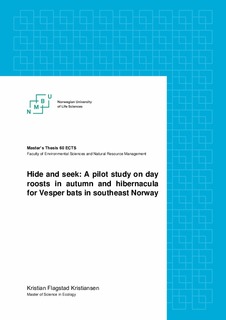| dc.description.abstract | 1. Bats constitute >20% of all terrestrial mammal species in Norway (12 resident species, 7 on the national Red list). Yet, the knowledge of their distribution, population trends and potential threats in Norway is very limited. Little is known about the locations of hibernacula (overwintering sites) in Norway. Hibernacula are a vital part of the life history strategy of bats, and information about the location and characteristics of such sites is much needed for knowledge-based management and conservation.
2. The main objective of the study was to identify hibernacula and roost sites of northern bats (Eptesicus nilsonii), Daubenton’s bats (Myotis daubentonii) and brown long-eared bats (Plecotus auritus) during autumn, the period of the year when the bat activity is reduced and eventually ends in Norway.
3. 15 bats were captured using mist nets and harp traps in Nittedal municipality (Akershus county), and fitted with radio transmitters. Radio telemetry was used to identify day roost sites and to observe the movements of the radio tagged individuals. Stationary bat recorders (with adjacent temperature loggers) were deployed at three sites: in front of a barn cellar, a mine and a scree, to automatically observe the activity of the bats. Hibernacula surveys from seven mines in southeast Norway (1981-2017) were supplemented with new field registrations in 2017-2018, and the dataset was analyzed to determine which factors affect species composition and location of bats in human-made mines.
4. The use of radio telemetry resulted in identification of 11 different roost sites; of northern bats (2), Daubenton’s bats (1) and brown long-eared bats (9), but no new hibernacula. Roost site use varied substantially between individuals, with some bats being stationary in one roost, whilst others changed roost every day. Activity recorded by use of automatic bat loggers showed that the bats were less active later in the autumn. Analysis of the hibernacula survey data showed that the mines in Sognsvann, Djupdal, Engelstadtjern and Røysåsen had substantial increases in total number of individuals over the survey years, Spenningsby had a slight increase, whereas Alnsjøen and Engelstadvang showed no significant changes. As both the inside and outside temperature of the mine at Sognsvann increased, the number of bat individuals decreased. Both the whiskered bat/Brandt’s bat and the Daubenton’s bat hibernated deeper into the mines than the northern bat and the brown long eared bat.
5. Radio telemetry worked well for locating autumn roost sites, but proved challenging for finding hibernacula during autumn; despite considerable efforts and resources, it yielded little empirical data. A need for further research on possible overwintering sites is evident to ensure evidence-based management and conservation of bats. | nb_NO |

